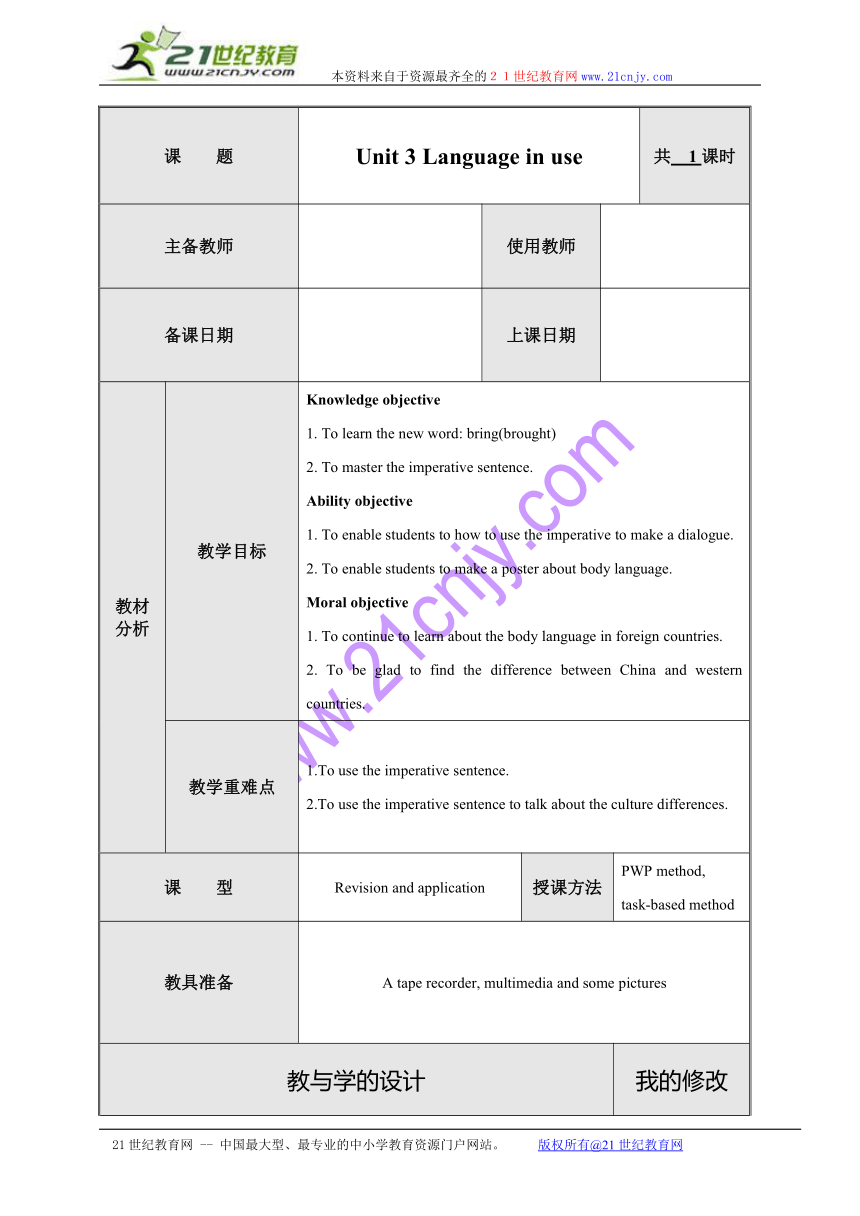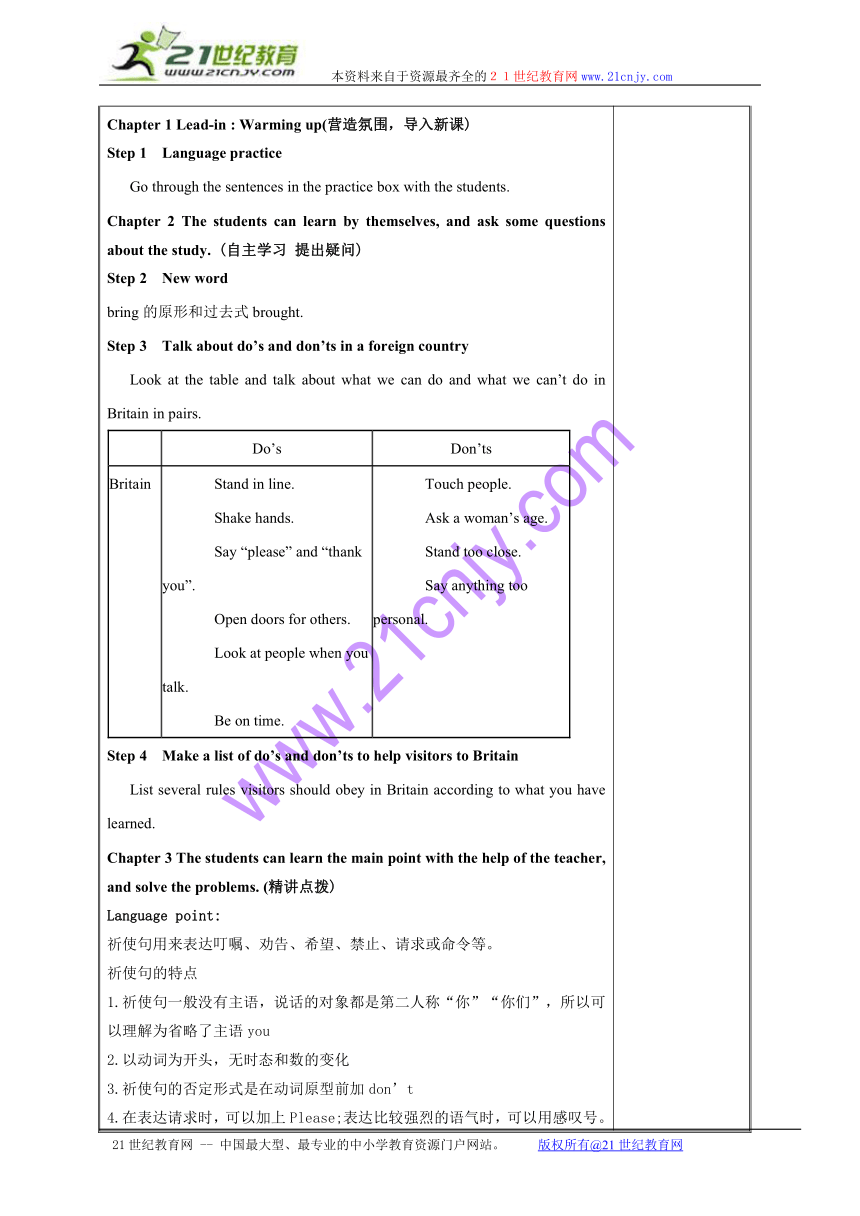Module 11 Body language. Unit 3 Language in use.教案
文档属性
| 名称 | Module 11 Body language. Unit 3 Language in use.教案 |  | |
| 格式 | zip | ||
| 文件大小 | 19.3KB | ||
| 资源类型 | 教案 | ||
| 版本资源 | 外研版 | ||
| 科目 | 英语 | ||
| 更新时间 | 2015-09-30 22:18:28 | ||
图片预览


文档简介
本资料来自于资源最齐全的21世纪教育网www.21cnjy.com
课 题 Unit 3 Language in use 共 1课时
主备教师 使用教师
备课日期 上课日期
教材分析 教学目标 Knowledge objective1 ( http: / / www.21cnjy.com ). To learn the new word: bring(brought)2. To master the imperative sentence.Ability objective1. To enable student ( http: / / www.21cnjy.com )s to how to use the imperative to make a dialogue.2. To enable students to make a poster about body language.Moral objective1. To continue to learn about the body language in foreign countries.2. To be glad to find the difference between China and western countries.
教学重难点 1.To use the imperati ( http: / / www.21cnjy.com )ve sentence.2.To use the imperative sentence to talk about the culture differences.
课 型 Revision and application 授课方法 PWP method,task-based method
教具准备 A tape recorder, multimedia and some pictures
教与学的设计 我的修改
Chapter 1 Lead-in : Warming up(营造氛围,导入新课)Step 1 Language practice Go through the sentences in the practice box with the students.Chapter 2 The ( http: / / www.21cnjy.com ) students can learn by themselves, and ask some questions about the study. (自主学习 提出疑问)Step 2 New wordbring的原形和过去式brought.Step 3 Talk about do’s and don’ts in a foreign country Look at the tabl ( http: / / www.21cnjy.com )e and talk about what we can do and what we can’t do in Britain in pairs. Do’sDon’tsBritainStand in line.Shake hands.Say “please” and “thank you”.Open doors for others.Look at people when you talk.Be on time.Touch people.Ask a woman’s age.Stand too close.Say anything too personal.Step 4 Make a list of do’s and don’ts to help visitors to BritainList several rule ( http: / / www.21cnjy.com )s visitors should obey in Britain according to what you have learned.Chapter 3 The stu ( http: / / www.21cnjy.com )dents can learn the main point with the help of the teacher, and solve the problems. (精讲点拨)Language point:祈使句用来表达叮嘱、劝告、希望、禁止、请求或命令等。祈使句的特点1.祈使句一般没有主语,说话的对象都是第二人称“你”“你们”,所以可以理解为省略了主语you2.以动词为开头,无时态和数的变化3.祈使句的否定形式是在动词原型前加don’t4.在表达请求时,可以加上Please;表达比较强烈的语气时,可以用感叹号。Chapter 4 Effective practice, consolidate the knowledge(训练巩固) Step 5 Rewrite the sentenceFirst, let Ss look at ( http: / / www.21cnjy.com )the example. Then let Ss follow the example to finish the following five sentences. The main purpose is to master the imperative sentence.KEY: 1.be careful 2. Clean and tidy the lab 3. Don’t touch anything if the teacher doesn’t ask you to 4. Don’t bring food or drink into the lab 5.Don’t enter the lab alone.Step 6 Answer the questions Read the w ( http: / / www.21cnjy.com )ords in the box, then answer the questions using the words and expressions. Key: 1. They shake hands with each other 2. No, it doesn’t. 3. They usually kiss three times 4. No, it isn’t 5. No, it isn’t 6. I wave my handStep 7 Around the worldLet Ss learn about the Japanese bow.Chapter 5 Summary evaluation, leak turnover(总结评价,查漏补缺)Step 8 Module task 1. Talk abou ( http: / / www.21cnjy.com )t different ways of saying hello and body language in China Work in pairs ( http: / / www.21cnjy.com ). As a Chinese, we have our own ways of saying hello and body language in China. Please talk about them in pairs.2. Write the information on your poster After talking ( http: / / www.21cnjy.com ) about the ways, you can write the information on your poster.3. Find or draw some pictures to add to your poster Collect som ( http: / / www.21cnjy.com )e pictures from the newspaper and magazines and add them to the poster.
作业布置 1. finish the exercisebooks.2. Finish your poster.
板书设计 Unit 3 Language in use1.祈使句一般没有主语,说话的对象都是第二人称“你”“你们”,所以可以理解为省略了主语you2.以动词为开头,无时态和数的变化3.祈使句的否定形式是在动词原型前加don’t4.在表达请求时,可以加上Please;表达比较强烈的语气时,可以用感叹号。
课后反思 本模块的重点是训练学生对祈使句的理解和使 ( http: / / www.21cnjy.com )用。教师首先应让学生了解祈使句通常在什么样的语境中,所表达的意义是什么?,然后训练学生自己尝试使用祈使句。在教学中,教师可以通过提供多种语境,惊醒大量的语言和文化知识的总结和呈现,同时也是进一步学习新知识的过程。
21世纪教育网 -- 中国最大型、最专业的中小学教育资源门户网站。 版权所有@21世纪教育网
课 题 Unit 3 Language in use 共 1课时
主备教师 使用教师
备课日期 上课日期
教材分析 教学目标 Knowledge objective1 ( http: / / www.21cnjy.com ). To learn the new word: bring(brought)2. To master the imperative sentence.Ability objective1. To enable student ( http: / / www.21cnjy.com )s to how to use the imperative to make a dialogue.2. To enable students to make a poster about body language.Moral objective1. To continue to learn about the body language in foreign countries.2. To be glad to find the difference between China and western countries.
教学重难点 1.To use the imperati ( http: / / www.21cnjy.com )ve sentence.2.To use the imperative sentence to talk about the culture differences.
课 型 Revision and application 授课方法 PWP method,task-based method
教具准备 A tape recorder, multimedia and some pictures
教与学的设计 我的修改
Chapter 1 Lead-in : Warming up(营造氛围,导入新课)Step 1 Language practice Go through the sentences in the practice box with the students.Chapter 2 The ( http: / / www.21cnjy.com ) students can learn by themselves, and ask some questions about the study. (自主学习 提出疑问)Step 2 New wordbring的原形和过去式brought.Step 3 Talk about do’s and don’ts in a foreign country Look at the tabl ( http: / / www.21cnjy.com )e and talk about what we can do and what we can’t do in Britain in pairs. Do’sDon’tsBritainStand in line.Shake hands.Say “please” and “thank you”.Open doors for others.Look at people when you talk.Be on time.Touch people.Ask a woman’s age.Stand too close.Say anything too personal.Step 4 Make a list of do’s and don’ts to help visitors to BritainList several rule ( http: / / www.21cnjy.com )s visitors should obey in Britain according to what you have learned.Chapter 3 The stu ( http: / / www.21cnjy.com )dents can learn the main point with the help of the teacher, and solve the problems. (精讲点拨)Language point:祈使句用来表达叮嘱、劝告、希望、禁止、请求或命令等。祈使句的特点1.祈使句一般没有主语,说话的对象都是第二人称“你”“你们”,所以可以理解为省略了主语you2.以动词为开头,无时态和数的变化3.祈使句的否定形式是在动词原型前加don’t4.在表达请求时,可以加上Please;表达比较强烈的语气时,可以用感叹号。Chapter 4 Effective practice, consolidate the knowledge(训练巩固) Step 5 Rewrite the sentenceFirst, let Ss look at ( http: / / www.21cnjy.com )the example. Then let Ss follow the example to finish the following five sentences. The main purpose is to master the imperative sentence.KEY: 1.be careful 2. Clean and tidy the lab 3. Don’t touch anything if the teacher doesn’t ask you to 4. Don’t bring food or drink into the lab 5.Don’t enter the lab alone.Step 6 Answer the questions Read the w ( http: / / www.21cnjy.com )ords in the box, then answer the questions using the words and expressions. Key: 1. They shake hands with each other 2. No, it doesn’t. 3. They usually kiss three times 4. No, it isn’t 5. No, it isn’t 6. I wave my handStep 7 Around the worldLet Ss learn about the Japanese bow.Chapter 5 Summary evaluation, leak turnover(总结评价,查漏补缺)Step 8 Module task 1. Talk abou ( http: / / www.21cnjy.com )t different ways of saying hello and body language in China Work in pairs ( http: / / www.21cnjy.com ). As a Chinese, we have our own ways of saying hello and body language in China. Please talk about them in pairs.2. Write the information on your poster After talking ( http: / / www.21cnjy.com ) about the ways, you can write the information on your poster.3. Find or draw some pictures to add to your poster Collect som ( http: / / www.21cnjy.com )e pictures from the newspaper and magazines and add them to the poster.
作业布置 1. finish the exercisebooks.2. Finish your poster.
板书设计 Unit 3 Language in use1.祈使句一般没有主语,说话的对象都是第二人称“你”“你们”,所以可以理解为省略了主语you2.以动词为开头,无时态和数的变化3.祈使句的否定形式是在动词原型前加don’t4.在表达请求时,可以加上Please;表达比较强烈的语气时,可以用感叹号。
课后反思 本模块的重点是训练学生对祈使句的理解和使 ( http: / / www.21cnjy.com )用。教师首先应让学生了解祈使句通常在什么样的语境中,所表达的意义是什么?,然后训练学生自己尝试使用祈使句。在教学中,教师可以通过提供多种语境,惊醒大量的语言和文化知识的总结和呈现,同时也是进一步学习新知识的过程。
21世纪教育网 -- 中国最大型、最专业的中小学教育资源门户网站。 版权所有@21世纪教育网
同课章节目录
- Module 1 Lost and found
- Unit 1 Whose bag is this?
- Unit 2 Are they yours?
- Unit 3 Language in use
- Module 2 What can you do ?
- Unit 1 I can play the piano
- Unit 2 I can run really fast
- Unit 3 Language in use
- Module 3 Making plans
- Unit 1 What are you going to do at the weekends?
- Unit 2 We're going to cheer the players.
- Unit 3 Language in use
- Module 4 Life in the future
- Unit 1 Everyone will study at home
- Unit 2 Every family will have a small plane.
- Unit 3 Language in use
- Module 5 Shopping
- Unit 1 What can I do for you?
- Unit 2 You can buy everything on the Internet
- Unit 3 Language in use
- Module 6 Around town
- Unit 1 Could you tell me how to get to the Nationa
- Unit 2 The London Eye is on your right.
- Unit 3 Language in use
- Revision module A
- Module 7 My past life
- Unit 1 I was born in a small village.
- Unit 2 I was born in Quincy.
- Unit 3 Language in use
- Module 8 Story time
- Unit 1 Once upon a time….
- Unit 2 Goldilocks hurried out of the house.
- Unit 3 Language in use
- Module 9 Life history
- Unit 1 He left school and began work at the age of
- Unit 2 He decided to be an actor.
- Unit 3 Language in use
- Module 10 A holiday journey
- Unit 1 What did you do?
- Unit 2 This morning we took a walk.
- Unit 3 Language in use
- Module 11 Body language
- Unit 1 They touch noses!
- Unit 2 Here are some ways to welcome them.
- Unit 3 Language in use
- Module 12 Western music
- Unit 1 It's so beautiful!
- Unit 2 Vienna is the centre of European classical
- Unit 3 Language in use
- Revision module B
